Portal:Australia/Featured picture/2007
| This page is currently inactive and is retained for historical reference. Either the page is no longer relevant or consensus on its purpose has become unclear. To revive discussion, seek broader input via a forum such as the village pump. |
| This Wikipedia page has been superseded by Portal:Australia/Selected picture and is retained primarily for historical reference. |
| Note: Images entries are now being displayed at Portal:Australia/Selected picture. However, this page should be retained for historical reference. |
Featured pictures in 2007[edit]
- Week 1

New Year's Eve in Australia is celebrated with public events in most major centres. Celebrations typically include substantial fireworks displays and musical entertainment. The New Year's Eve event in Sydney is one of the largest celebrations in the world, with in excess of one million people gathering at vantage points around Sydney Harbour to view a fireworks centred on the Sydney Harbour Bridge.
Photo credit: Kvasir
- Week 6
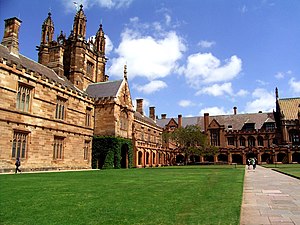
The University of Sydney, established in Sydney in 1850, is the oldest university in Australia. It is a member of Australia's "Group of Eight" Australian universities that are highly ranked in terms of their research performance, and is one of the country's most prestigious educational institutions. In 2005, the University of Sydney had 45,966 students and 2,300 (full-time equivalent) academic staff, making it the second largest in Australia. The university's main campus has Oxbridge-inspired grounds and is situated in the south-west of the Sydney central business district.
Photo credit: User:KittySaturn
- Week 7

Campbell Park, together with Russell Offices, is the headquarters of the Australian Defence Force (ADF). It is located in Canberra, the national capital of Australia, in the suburb of Campbell. The building looks eastward across the Majura Valley and Canberra International Airport and backs onto Mount Ainslie. The main offices of the Department of Defence and the ADF's administrative headquarters are located in the Russell Offices.
Photo credit: Nick Dowling
- Week 8
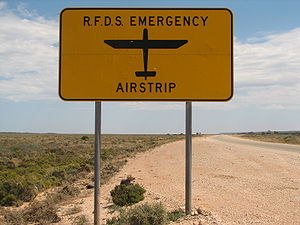
The Royal Flying Doctor Service of Australia (RFDS, informally known as The Flying Doctors) is an air ambulance service for those living in the remote inland areas of Australia. It is a not-for-profit organisation which provides both emergency assistance and primary health care to people who cannot easily access a hospital or general practice due to the prohibitive distances of the Outback. The service, founded in 1928 by The Reverend John Flynn, also assists with distance education.
Photo credit: Hossen
- Week 12
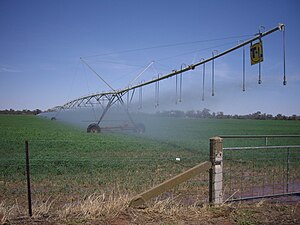
Irrigation in Australia is a widespread practice to supplement low rainfall levels in Australia with water from other sources to assist in the production of crops or pasture. As the driest inhabited continent, irrigation is required in many areas for production of crops for domestic and export use. Irrigation differs from dryland farming (farming relying on rainfall) in Australia in its level of intensity and production.
Photo credit: Virtual Steve
- Week 13
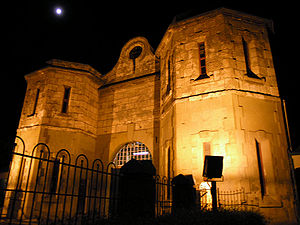
Fremantle Prison is a former Australian prison located in Fremantle in Western Australia. The 60,000 m² site includes the prison, gatehouse, perimeter walls, cottages, tunnels, and prisoner art. The prison was built by convict labour in the 1850s, and transferred to the colonial government in 1886 for use as a gaol for locally-sentenced prisoners. It closed as a prison in 1991 and re-opened as a historic site and is now a public museum.
Photo credit: Sean Mack
- Week 15

- Week 16

The Western Australian Museum is the main museum for the state of Western Australia. Established in 1891, the museum is situated in the heart of Perth's cultural precinct in Northbridge.
Photo credit: Greg O'Beirne
- Week 19
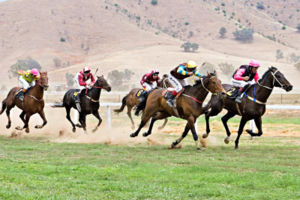
Horseracing is the third most popular spectator sport in Australia, behind Australian rules football and rugby league, with almost 2 million admissions to the 379 racecourses throughout Australia in 2002–03. It is administered nationally by the Australian Racing Board, with the Australian Rules of Racing applying in each state.
Photo credit: Fir0002
- Week 23

Luna Park Sydney (originally Luna Park Milsons Point, now formally Sydney's Luna Park) is a historical amusement park, located on the northern shore of Sydney Harbour in Sydney. The heritage-listed park first opened in 1935, and is open for business as of 2007[update], but over its 70-year history, the park has experienced multiple closures, changes of ownership, legal battles, and community action in both support of and opposition to Luna Park's operation.
Photo credit: Joanjoc
- Week 27
John Landy (born 12 April 1930) is a former track athlete and was the 26th Governor of Victoria. Landy became the second man after Roger Bannister to achieve a sub-4 minute mile, recording a world record time of 3:58.0 minutes in Finland. He subsequently achieved the same in what was dubbed the The Miracle Mile at the 1954 British Empire Games.
Photo credit: Max Stevens
- Week 28
John Landy (born 12 April 1930) is a former track athlete and was the 26th Governor of Victoria. Landy became the second man after Roger Bannister to achieve a sub-4 minute mile, recording a world record time of 3:58.0 minutes in Finland. He subsequently achieved the same in what was dubbed the The Miracle Mile at the 1954 British Empire Games.
Photo credit: Max Stevens
- Week 33

The 2000 Summer Olympics, or the Millennium Games, were the Summer Olympic Games held in 2000 in the New South Welsh capital of Sydney. Hailed as the "best Olympic Games ever", it was the first to be held in Australia since the 1956 Summer Olympics in Melbourne. The top five medal-takers of the Sydney Olympics were the United States, Russia, China, Australia and Germany.
Photo credit: Robert A. Whitehead
- Week 34

Wattle Point Wind Farm is a wind farm near Edithburgh on the coast of South Australia. Upon officially opening in June 2005 it became Australia's largest wind farm at 91 megawatts. The installation consists of 55 wind turbines and was built at a cost of around AU$165 million.
Photo credit: Scott Davis
- Week 35
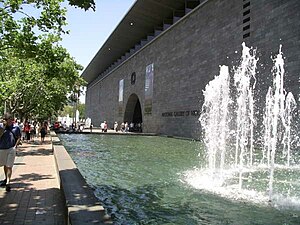
The National Gallery of Victoria is an art gallery and museum in the Victorian capital of Melbourne. Founded in 1861, it is the oldest and the largest public art gallery in Australia. At that time of the gallery's establishment, Victoria had been an independent colony for just ten years, but in the wake of the Victorian gold rush, it was the wealthiest part of Australia, and Melbourne the largest city. Generous gifts from moneyed citizens, notably industrialist Alfred Felton, made it possible for it to begin buying a large collection of overseas works from both old and modern masters.
Photo credit: Robert Merkel
- Week 47

The Koala (Phascolarctos cinereus) is a thickset arboreal marsupial herbivore native to Australia, and the only extant representative of the family Phascolarctidae.
The Koala is found in coastal regions of eastern and southern Australia, from near Adelaide to the southern part of Cape York Peninsula. Populations also extend for considerable distances inland in regions with enough moisture to support suitable woodlands. The Koalas of South Australia were largely exterminated during the early part of the 20th century, but the state has since been repopulated with Victorian stock. The Koala is not found in Tasmania or Western Australia.
Photo credit: Guillaume Blanchard
- Week 48

The Yarra River is a river in southern Victoria, Australia. It is the river on which the city of Melbourne was founded. The river measures in at 242 kilometres (150 mi), starting in swamps of the Yarra Ranges National Park and eventually flows into Port Phillip, Melbourne's busiest sea port.
Photo credit: David Iliff
- Week 49

The Three Sisters are a famous rock formation in the Blue Mountains of New South Wales, Australia. They are close to the town of Katoomba and are one of the Blue Mountains' most famous sights, towering above the Jamison Valley. Their names are Meehni (922 m), Wimlah (918 m), and Gunnedoo (906 m).
Photo credit: David Iliff
